Report on Managing Financial Resources and Business Decisions, Finance
VerifiedAdded on 2020/01/15
|22
|4834
|237
Report
AI Summary
This report delves into the critical aspects of managing financial resources and making sound financial decisions within a business context. It begins by identifying and analyzing various sources of finance available to businesses, including owner's capital, retained earnings, third-party investments, and the sale of fixed assets, along with their respective implications. The report then examines the implications of finance as a resource, covering the costs associated with different funding sources, the key aspects of financial planning, and the importance of financial decision-making. Furthermore, the report includes sample financial statements like profit and loss accounts and balance sheets to illustrate financial concepts. The study then progresses to real-world scenarios, including sales budget analysis and cash flow forecasts, to demonstrate how financial decisions are made in practice. Finally, the report assesses the financial performance of businesses through the use of accounting terminology and financial statements.
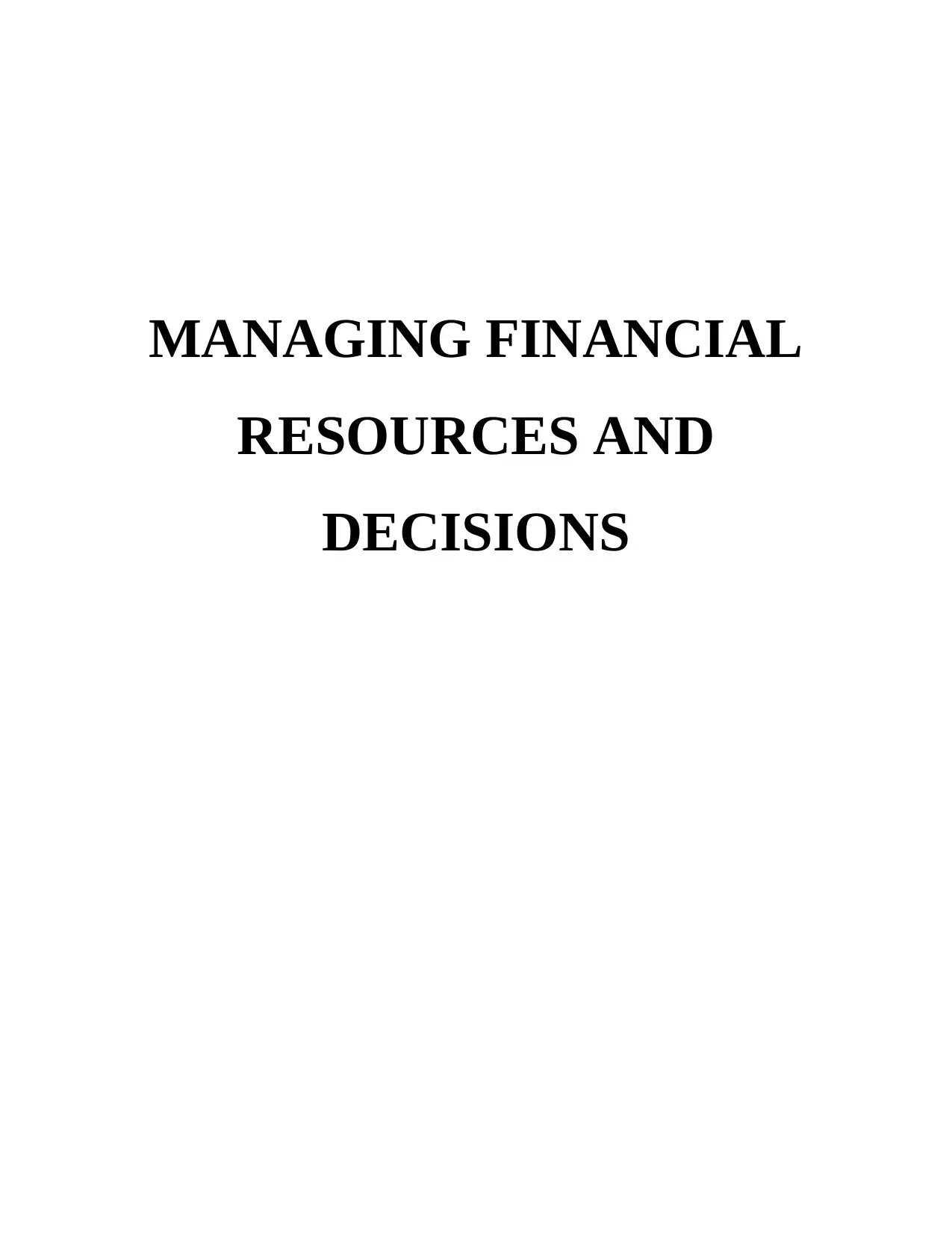
MANAGING FINANCIAL
RESOURCES AND
DECISIONS
RESOURCES AND
DECISIONS
Paraphrase This Document
Need a fresh take? Get an instant paraphrase of this document with our AI Paraphraser
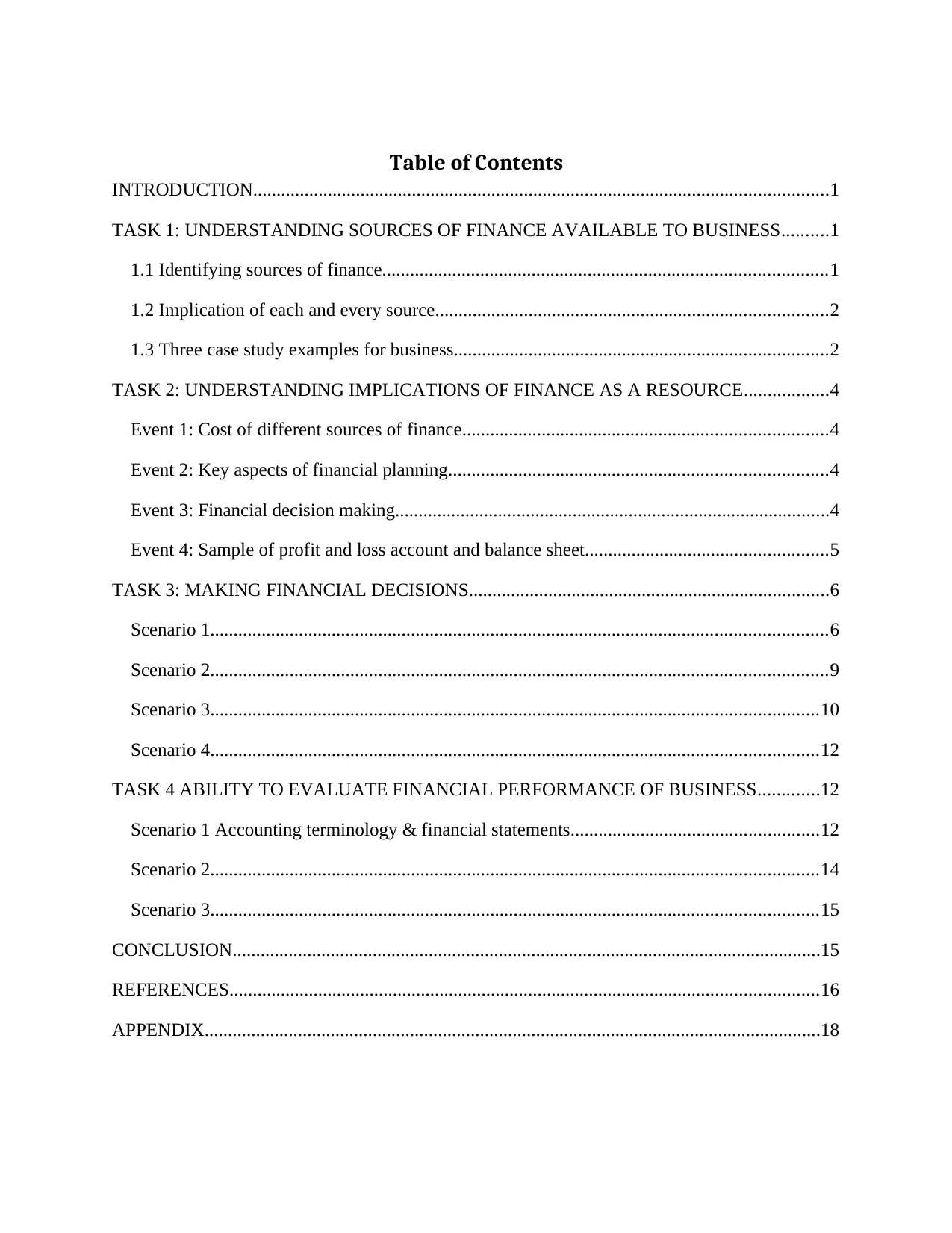
Table of Contents
INTRODUCTION...........................................................................................................................1
TASK 1: UNDERSTANDING SOURCES OF FINANCE AVAILABLE TO BUSINESS..........1
1.1 Identifying sources of finance...............................................................................................1
1.2 Implication of each and every source....................................................................................2
1.3 Three case study examples for business................................................................................2
TASK 2: UNDERSTANDING IMPLICATIONS OF FINANCE AS A RESOURCE..................4
Event 1: Cost of different sources of finance..............................................................................4
Event 2: Key aspects of financial planning.................................................................................4
Event 3: Financial decision making.............................................................................................4
Event 4: Sample of profit and loss account and balance sheet....................................................5
TASK 3: MAKING FINANCIAL DECISIONS.............................................................................6
Scenario 1....................................................................................................................................6
Scenario 2....................................................................................................................................9
Scenario 3..................................................................................................................................10
Scenario 4..................................................................................................................................12
TASK 4 ABILITY TO EVALUATE FINANCIAL PERFORMANCE OF BUSINESS.............12
Scenario 1 Accounting terminology & financial statements.....................................................12
Scenario 2..................................................................................................................................14
Scenario 3..................................................................................................................................15
CONCLUSION..............................................................................................................................15
REFERENCES..............................................................................................................................16
APPENDIX....................................................................................................................................18
INTRODUCTION...........................................................................................................................1
TASK 1: UNDERSTANDING SOURCES OF FINANCE AVAILABLE TO BUSINESS..........1
1.1 Identifying sources of finance...............................................................................................1
1.2 Implication of each and every source....................................................................................2
1.3 Three case study examples for business................................................................................2
TASK 2: UNDERSTANDING IMPLICATIONS OF FINANCE AS A RESOURCE..................4
Event 1: Cost of different sources of finance..............................................................................4
Event 2: Key aspects of financial planning.................................................................................4
Event 3: Financial decision making.............................................................................................4
Event 4: Sample of profit and loss account and balance sheet....................................................5
TASK 3: MAKING FINANCIAL DECISIONS.............................................................................6
Scenario 1....................................................................................................................................6
Scenario 2....................................................................................................................................9
Scenario 3..................................................................................................................................10
Scenario 4..................................................................................................................................12
TASK 4 ABILITY TO EVALUATE FINANCIAL PERFORMANCE OF BUSINESS.............12
Scenario 1 Accounting terminology & financial statements.....................................................12
Scenario 2..................................................................................................................................14
Scenario 3..................................................................................................................................15
CONCLUSION..............................................................................................................................15
REFERENCES..............................................................................................................................16
APPENDIX....................................................................................................................................18

INTRODUCTION
Managing financial resources plays most important role in business as through this it
becomes easy for management to accomplish desired goals and objectives. Further, it is well
known fact that finance is regarded as one of the main resource of business without which no
business can survive in the market (Broadbent and Cullen, 2012). Therefore, large numbers of
efforts are applied by company so that all its major resources can be utilized in efficient manner.
Apart from this, different sources of finance are present which business considers for satisfying
its financial needs. Further, each source has its own implications which management of every
enterprise has to consider as it is associated with growth and overall development. The present
study is associated with different case where different tasks have been covered in the study
which takes into consideration implications of sources of finance, cost of different sources of
finance, importance of financial planning etc.
TASK 1: UNDERSTANDING SOURCES OF FINANCE AVAILABLE TO
BUSINESS
1.1 Identifying sources of finance
Different sources of finance are available with business which can be considered for carrying
out operations in effective manner (Cox and Fardon, 2003). Further, they are present for large
sized companies, entrepreneur or in case of any company which is interested in taking expansion
decision. Following are the sources of finance available for new and old, large and small, for
new business start up and those who are planning to expand in the market.
Owner’s capital: This source can be considered by businesses in case of setting up new
venture. Main reason behind selection of this source is that entrepreneur already own
capital and cost of acquisition is very minimum. Considering the present case this source
can be adopted by entrepreneurs who are planning to open up new venture.
Retained earnings: It is the amount kept by business to meet any unforeseen
contingency. This source can be adopted by existing businesses and through this it is
possible to satisfy financial needs in efficient manner (Cunningham, 2006). Further, it is
appropriate for large and medium sized businesses who can carry out operations in
effective manner.
1
Managing financial resources plays most important role in business as through this it
becomes easy for management to accomplish desired goals and objectives. Further, it is well
known fact that finance is regarded as one of the main resource of business without which no
business can survive in the market (Broadbent and Cullen, 2012). Therefore, large numbers of
efforts are applied by company so that all its major resources can be utilized in efficient manner.
Apart from this, different sources of finance are present which business considers for satisfying
its financial needs. Further, each source has its own implications which management of every
enterprise has to consider as it is associated with growth and overall development. The present
study is associated with different case where different tasks have been covered in the study
which takes into consideration implications of sources of finance, cost of different sources of
finance, importance of financial planning etc.
TASK 1: UNDERSTANDING SOURCES OF FINANCE AVAILABLE TO
BUSINESS
1.1 Identifying sources of finance
Different sources of finance are available with business which can be considered for carrying
out operations in effective manner (Cox and Fardon, 2003). Further, they are present for large
sized companies, entrepreneur or in case of any company which is interested in taking expansion
decision. Following are the sources of finance available for new and old, large and small, for
new business start up and those who are planning to expand in the market.
Owner’s capital: This source can be considered by businesses in case of setting up new
venture. Main reason behind selection of this source is that entrepreneur already own
capital and cost of acquisition is very minimum. Considering the present case this source
can be adopted by entrepreneurs who are planning to open up new venture.
Retained earnings: It is the amount kept by business to meet any unforeseen
contingency. This source can be adopted by existing businesses and through this it is
possible to satisfy financial needs in efficient manner (Cunningham, 2006). Further, it is
appropriate for large and medium sized businesses who can carry out operations in
effective manner.
1
⊘ This is a preview!⊘
Do you want full access?
Subscribe today to unlock all pages.

Trusted by 1+ million students worldwide
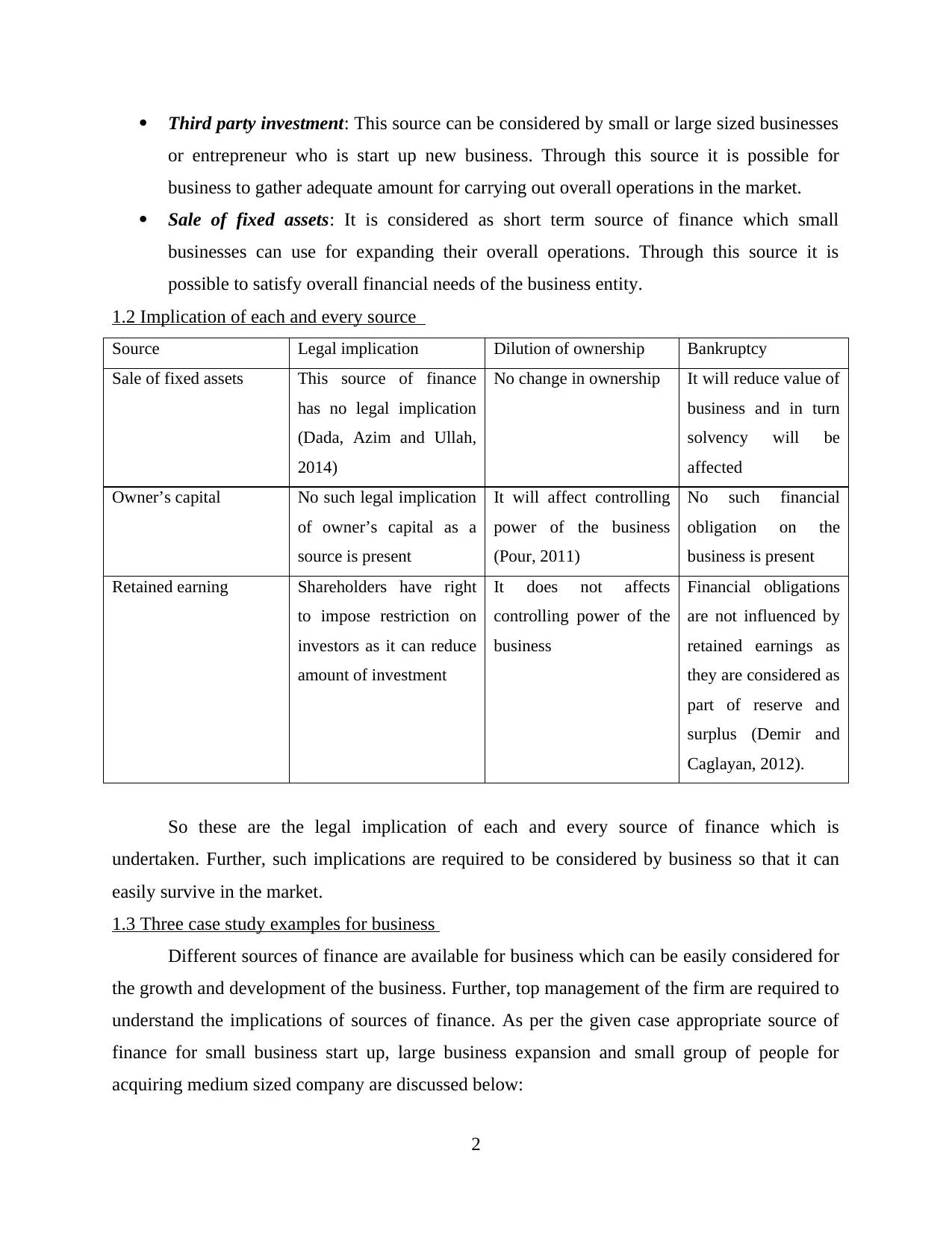
Third party investment: This source can be considered by small or large sized businesses
or entrepreneur who is start up new business. Through this source it is possible for
business to gather adequate amount for carrying out overall operations in the market.
Sale of fixed assets: It is considered as short term source of finance which small
businesses can use for expanding their overall operations. Through this source it is
possible to satisfy overall financial needs of the business entity.
1.2 Implication of each and every source
Source Legal implication Dilution of ownership Bankruptcy
Sale of fixed assets This source of finance
has no legal implication
(Dada, Azim and Ullah,
2014)
No change in ownership It will reduce value of
business and in turn
solvency will be
affected
Owner’s capital No such legal implication
of owner’s capital as a
source is present
It will affect controlling
power of the business
(Pour, 2011)
No such financial
obligation on the
business is present
Retained earning Shareholders have right
to impose restriction on
investors as it can reduce
amount of investment
It does not affects
controlling power of the
business
Financial obligations
are not influenced by
retained earnings as
they are considered as
part of reserve and
surplus (Demir and
Caglayan, 2012).
So these are the legal implication of each and every source of finance which is
undertaken. Further, such implications are required to be considered by business so that it can
easily survive in the market.
1.3 Three case study examples for business
Different sources of finance are available for business which can be easily considered for
the growth and development of the business. Further, top management of the firm are required to
understand the implications of sources of finance. As per the given case appropriate source of
finance for small business start up, large business expansion and small group of people for
acquiring medium sized company are discussed below:
2
or entrepreneur who is start up new business. Through this source it is possible for
business to gather adequate amount for carrying out overall operations in the market.
Sale of fixed assets: It is considered as short term source of finance which small
businesses can use for expanding their overall operations. Through this source it is
possible to satisfy overall financial needs of the business entity.
1.2 Implication of each and every source
Source Legal implication Dilution of ownership Bankruptcy
Sale of fixed assets This source of finance
has no legal implication
(Dada, Azim and Ullah,
2014)
No change in ownership It will reduce value of
business and in turn
solvency will be
affected
Owner’s capital No such legal implication
of owner’s capital as a
source is present
It will affect controlling
power of the business
(Pour, 2011)
No such financial
obligation on the
business is present
Retained earning Shareholders have right
to impose restriction on
investors as it can reduce
amount of investment
It does not affects
controlling power of the
business
Financial obligations
are not influenced by
retained earnings as
they are considered as
part of reserve and
surplus (Demir and
Caglayan, 2012).
So these are the legal implication of each and every source of finance which is
undertaken. Further, such implications are required to be considered by business so that it can
easily survive in the market.
1.3 Three case study examples for business
Different sources of finance are available for business which can be easily considered for
the growth and development of the business. Further, top management of the firm are required to
understand the implications of sources of finance. As per the given case appropriate source of
finance for small business start up, large business expansion and small group of people for
acquiring medium sized company are discussed below:
2
Paraphrase This Document
Need a fresh take? Get an instant paraphrase of this document with our AI Paraphraser

Case 1: Appropriate source of finance for small business start up
For new business operating on smaller basis it is necessarily required to consider the
appropriate source of finance for its benefit. For setting up small business two sources are
effective which are bank loan and personal savings. Obtaining bank loan can be appropriate for
business through which long term needs of business can be satisfied easily (Dransfield, 2004).
Further, its repayment is based on monthly installment which small business can easily do. Apart
from this, owner’s capital is also effective source of finance for small business which is newly
established. Further, there is no such liability on the part of company but in case if investment
amount is not utilized properly then it can have adverse impact on business.
Case 2: Sources of finance for large business expansion
In the present scenario case of existing firm has been taken into consideration who wants
to expand operations in the market. For instance business has taken registration for initial public
offering. Different internal along with external sources of finance are available for business.
Issuing shares in the market is one of the main source through which funds can be acquired for
the expansion purpose. Main reason behind recommending this source is that business can
acquire large funds at an minimum cost (Flynn, Uliana and Wormald, 2012). On the other hand
dividend has to be paid to investors.
Second appropriate source for business is retained earnings as usually large businesses
have high savings and the amount can be utilized for expansion purpose. Therefore, this is also
one of the most appropriate sources for business and can support in accomplishment of long term
objectives. Main advantage of this source is that it saves cost associated with acquiring funds but
on the other hand it reduces overall savings of the company.
Case 3: Sources of finance for small group of people
For small group of people carrying out operations in the market main effective source of
finance is venture capital and government grant. Main benefit of considering government grant
as an appropriate source of finance is that government of UK promotes investment for
expansion. Apart from this venture capitalist is also appropriate source through which group of
people can buy existing firm. But this source enhances duty of management to provide up to date
information to investors so that they can identify business risk.
3
For new business operating on smaller basis it is necessarily required to consider the
appropriate source of finance for its benefit. For setting up small business two sources are
effective which are bank loan and personal savings. Obtaining bank loan can be appropriate for
business through which long term needs of business can be satisfied easily (Dransfield, 2004).
Further, its repayment is based on monthly installment which small business can easily do. Apart
from this, owner’s capital is also effective source of finance for small business which is newly
established. Further, there is no such liability on the part of company but in case if investment
amount is not utilized properly then it can have adverse impact on business.
Case 2: Sources of finance for large business expansion
In the present scenario case of existing firm has been taken into consideration who wants
to expand operations in the market. For instance business has taken registration for initial public
offering. Different internal along with external sources of finance are available for business.
Issuing shares in the market is one of the main source through which funds can be acquired for
the expansion purpose. Main reason behind recommending this source is that business can
acquire large funds at an minimum cost (Flynn, Uliana and Wormald, 2012). On the other hand
dividend has to be paid to investors.
Second appropriate source for business is retained earnings as usually large businesses
have high savings and the amount can be utilized for expansion purpose. Therefore, this is also
one of the most appropriate sources for business and can support in accomplishment of long term
objectives. Main advantage of this source is that it saves cost associated with acquiring funds but
on the other hand it reduces overall savings of the company.
Case 3: Sources of finance for small group of people
For small group of people carrying out operations in the market main effective source of
finance is venture capital and government grant. Main benefit of considering government grant
as an appropriate source of finance is that government of UK promotes investment for
expansion. Apart from this venture capitalist is also appropriate source through which group of
people can buy existing firm. But this source enhances duty of management to provide up to date
information to investors so that they can identify business risk.
3
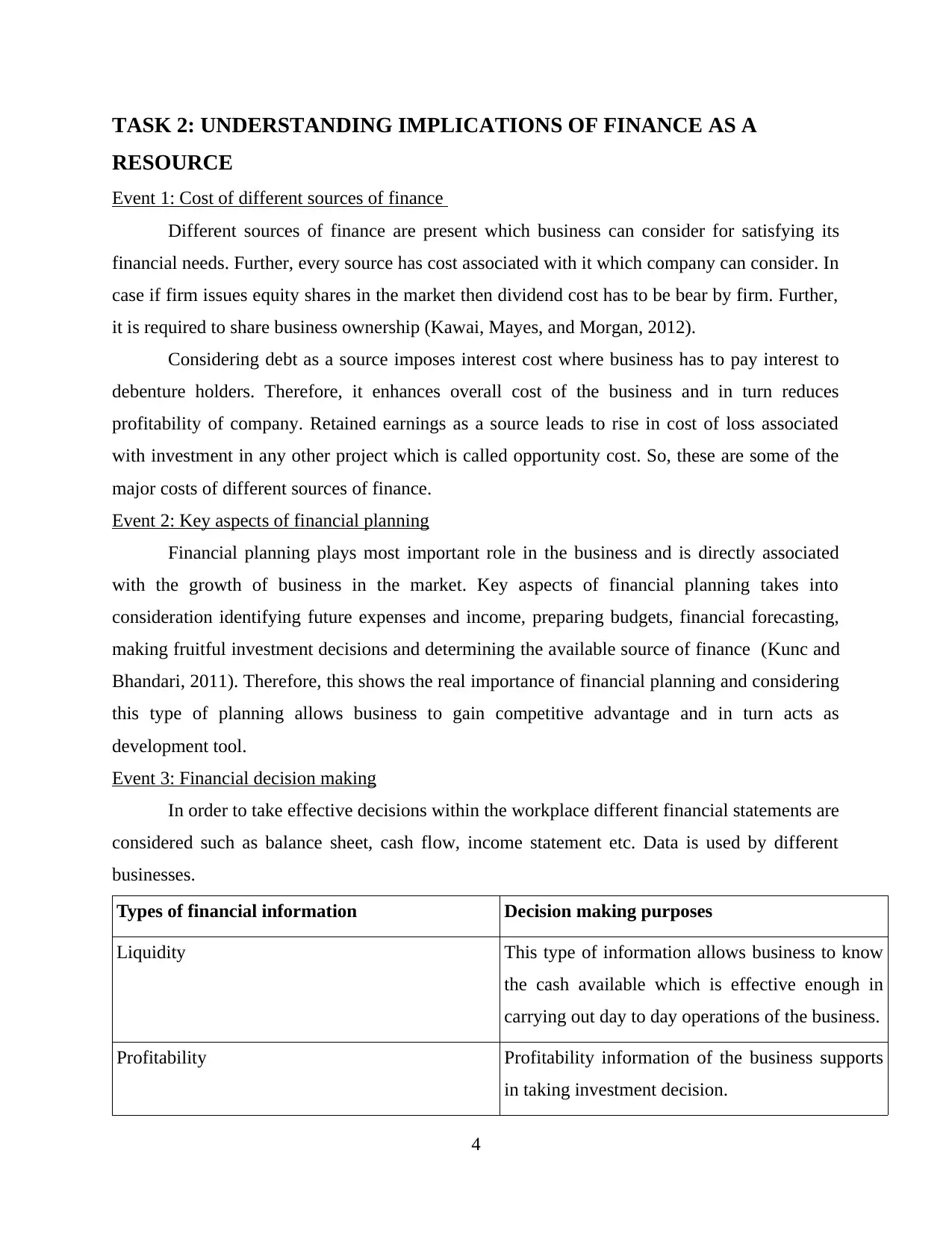
TASK 2: UNDERSTANDING IMPLICATIONS OF FINANCE AS A
RESOURCE
Event 1: Cost of different sources of finance
Different sources of finance are present which business can consider for satisfying its
financial needs. Further, every source has cost associated with it which company can consider. In
case if firm issues equity shares in the market then dividend cost has to be bear by firm. Further,
it is required to share business ownership (Kawai, Mayes, and Morgan, 2012).
Considering debt as a source imposes interest cost where business has to pay interest to
debenture holders. Therefore, it enhances overall cost of the business and in turn reduces
profitability of company. Retained earnings as a source leads to rise in cost of loss associated
with investment in any other project which is called opportunity cost. So, these are some of the
major costs of different sources of finance.
Event 2: Key aspects of financial planning
Financial planning plays most important role in the business and is directly associated
with the growth of business in the market. Key aspects of financial planning takes into
consideration identifying future expenses and income, preparing budgets, financial forecasting,
making fruitful investment decisions and determining the available source of finance (Kunc and
Bhandari, 2011). Therefore, this shows the real importance of financial planning and considering
this type of planning allows business to gain competitive advantage and in turn acts as
development tool.
Event 3: Financial decision making
In order to take effective decisions within the workplace different financial statements are
considered such as balance sheet, cash flow, income statement etc. Data is used by different
businesses.
Types of financial information Decision making purposes
Liquidity This type of information allows business to know
the cash available which is effective enough in
carrying out day to day operations of the business.
Profitability Profitability information of the business supports
in taking investment decision.
4
RESOURCE
Event 1: Cost of different sources of finance
Different sources of finance are present which business can consider for satisfying its
financial needs. Further, every source has cost associated with it which company can consider. In
case if firm issues equity shares in the market then dividend cost has to be bear by firm. Further,
it is required to share business ownership (Kawai, Mayes, and Morgan, 2012).
Considering debt as a source imposes interest cost where business has to pay interest to
debenture holders. Therefore, it enhances overall cost of the business and in turn reduces
profitability of company. Retained earnings as a source leads to rise in cost of loss associated
with investment in any other project which is called opportunity cost. So, these are some of the
major costs of different sources of finance.
Event 2: Key aspects of financial planning
Financial planning plays most important role in the business and is directly associated
with the growth of business in the market. Key aspects of financial planning takes into
consideration identifying future expenses and income, preparing budgets, financial forecasting,
making fruitful investment decisions and determining the available source of finance (Kunc and
Bhandari, 2011). Therefore, this shows the real importance of financial planning and considering
this type of planning allows business to gain competitive advantage and in turn acts as
development tool.
Event 3: Financial decision making
In order to take effective decisions within the workplace different financial statements are
considered such as balance sheet, cash flow, income statement etc. Data is used by different
businesses.
Types of financial information Decision making purposes
Liquidity This type of information allows business to know
the cash available which is effective enough in
carrying out day to day operations of the business.
Profitability Profitability information of the business supports
in taking investment decision.
4
⊘ This is a preview!⊘
Do you want full access?
Subscribe today to unlock all pages.

Trusted by 1+ million students worldwide
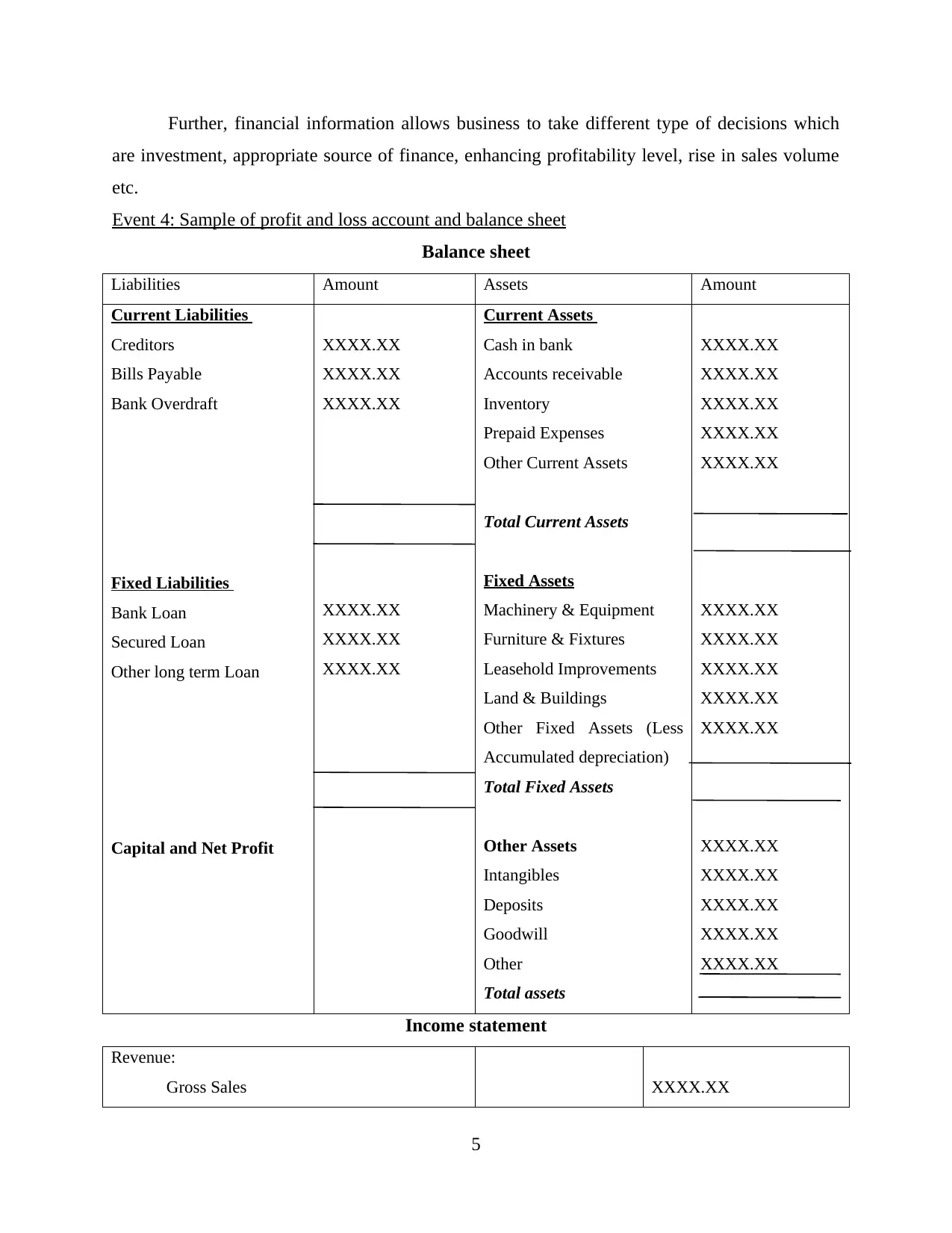
Further, financial information allows business to take different type of decisions which
are investment, appropriate source of finance, enhancing profitability level, rise in sales volume
etc.
Event 4: Sample of profit and loss account and balance sheet
Balance sheet
Liabilities Amount Assets Amount
Current Liabilities
Creditors
Bills Payable
Bank Overdraft
Fixed Liabilities
Bank Loan
Secured Loan
Other long term Loan
Capital and Net Profit
XXXX.XX
XXXX.XX
XXXX.XX
XXXX.XX
XXXX.XX
XXXX.XX
Current Assets
Cash in bank
Accounts receivable
Inventory
Prepaid Expenses
Other Current Assets
Total Current Assets
Fixed Assets
Machinery & Equipment
Furniture & Fixtures
Leasehold Improvements
Land & Buildings
Other Fixed Assets (Less
Accumulated depreciation)
Total Fixed Assets
Other Assets
Intangibles
Deposits
Goodwill
Other
Total assets
XXXX.XX
XXXX.XX
XXXX.XX
XXXX.XX
XXXX.XX
XXXX.XX
XXXX.XX
XXXX.XX
XXXX.XX
XXXX.XX
XXXX.XX
XXXX.XX
XXXX.XX
XXXX.XX
XXXX.XX
Income statement
Revenue:
Gross Sales XXXX.XX
5
are investment, appropriate source of finance, enhancing profitability level, rise in sales volume
etc.
Event 4: Sample of profit and loss account and balance sheet
Balance sheet
Liabilities Amount Assets Amount
Current Liabilities
Creditors
Bills Payable
Bank Overdraft
Fixed Liabilities
Bank Loan
Secured Loan
Other long term Loan
Capital and Net Profit
XXXX.XX
XXXX.XX
XXXX.XX
XXXX.XX
XXXX.XX
XXXX.XX
Current Assets
Cash in bank
Accounts receivable
Inventory
Prepaid Expenses
Other Current Assets
Total Current Assets
Fixed Assets
Machinery & Equipment
Furniture & Fixtures
Leasehold Improvements
Land & Buildings
Other Fixed Assets (Less
Accumulated depreciation)
Total Fixed Assets
Other Assets
Intangibles
Deposits
Goodwill
Other
Total assets
XXXX.XX
XXXX.XX
XXXX.XX
XXXX.XX
XXXX.XX
XXXX.XX
XXXX.XX
XXXX.XX
XXXX.XX
XXXX.XX
XXXX.XX
XXXX.XX
XXXX.XX
XXXX.XX
XXXX.XX
Income statement
Revenue:
Gross Sales XXXX.XX
5
Paraphrase This Document
Need a fresh take? Get an instant paraphrase of this document with our AI Paraphraser

Less : Sales Returns / Allowance
Net Sales
Cost of Goods Sold:
Purchases
Delivery Charges
Cost of goods sold
Gross sales profit (Loss)
Expenses:
Expenses 1
Expenses 2
Expenses 3
Total Expenses:
Net Operating Income
Other Income:
Income 1
Income 2
Income 3
Total Other Income:
Net Income (Loss):
XXXX.XX
XXXX.XX
XXXX.XX
XXXX.XX
XXXX.XX
XXXX.XX
XXXX.XX
XXXX.XX
XXXX.XX
XXXX.XX
XXXX.XX
XXXX.XX
XXXX.XX
XXXX.XX
XXXX.XX
XXXX.XX
TASK 3: MAKING FINANCIAL DECISIONS
Scenario 1
Sales budget
Month Monthly
budget
Cumulative
Budget
Actual
Monthly
Actual
Cumulative
Variance
July 230,000 230,000 215,000 215,000 -15,000
August 230,000 460,000 220,000 435,000 -25,000
September 270,000 730,000 245,000 680,000 -50,000
October 265,000 995,000 235,000 915,000 -80,000
6
Net Sales
Cost of Goods Sold:
Purchases
Delivery Charges
Cost of goods sold
Gross sales profit (Loss)
Expenses:
Expenses 1
Expenses 2
Expenses 3
Total Expenses:
Net Operating Income
Other Income:
Income 1
Income 2
Income 3
Total Other Income:
Net Income (Loss):
XXXX.XX
XXXX.XX
XXXX.XX
XXXX.XX
XXXX.XX
XXXX.XX
XXXX.XX
XXXX.XX
XXXX.XX
XXXX.XX
XXXX.XX
XXXX.XX
XXXX.XX
XXXX.XX
XXXX.XX
XXXX.XX
TASK 3: MAKING FINANCIAL DECISIONS
Scenario 1
Sales budget
Month Monthly
budget
Cumulative
Budget
Actual
Monthly
Actual
Cumulative
Variance
July 230,000 230,000 215,000 215,000 -15,000
August 230,000 460,000 220,000 435,000 -25,000
September 270,000 730,000 245,000 680,000 -50,000
October 265,000 995,000 235,000 915,000 -80,000
6

November 265,000 1,260,000 237,000 1,152,000 -108,000
December 300,000 1,560,000 270,000 1,422,000 -138,000
January 250,000 1,810,000
February 265,000 2,075,000
March 300,000 2,375,000
April 325,000 2,700,000
May 325,000 3,025,000
June 350,000 3,375,000
Cash forecasts
Jan Feb Mar Apr May Jun Jul Aug Sep Oct Nov Dec
Brought
Forward
40,000
Sales 200,000 300,000 300,000 300,000 250,000 260,000 300,000 260,000 300,000 325,000 265,000 265,000
Total Income 240,000 300,000 300,000 300,000 250,000 260,000 300,000 260,000 300,000 325,000 265,000 265,000
Purchases 150,000 140,000 135,000 135,000 140,000 130,000 135,000 145,000 140,000 140,000 145,000 145,000
Wages 55,000 55,000 55,000 55,000 55,000 55,000 55,000 55,000 55,000 55,000 55,000 55,000
Rent &
Rates
56,000 56,000 56,000 56,000
Light &
Heat
55,000 55,000 55,000 55,000
Advertising 2,000 2,000 2,000 2,000 2,000 2,000 2,000 2,000 2,000 2,000 2,000 2,000
Insurances 55,000 52,000
Equipment 50,000 10,000 10,000 10,000
Vehicles 20,000
Directors' 22,000 22,000 22,000 22,000 22,000 22,000 22,000 22,000 22,000 22,000 22,000 22,000
7
December 300,000 1,560,000 270,000 1,422,000 -138,000
January 250,000 1,810,000
February 265,000 2,075,000
March 300,000 2,375,000
April 325,000 2,700,000
May 325,000 3,025,000
June 350,000 3,375,000
Cash forecasts
Jan Feb Mar Apr May Jun Jul Aug Sep Oct Nov Dec
Brought
Forward
40,000
Sales 200,000 300,000 300,000 300,000 250,000 260,000 300,000 260,000 300,000 325,000 265,000 265,000
Total Income 240,000 300,000 300,000 300,000 250,000 260,000 300,000 260,000 300,000 325,000 265,000 265,000
Purchases 150,000 140,000 135,000 135,000 140,000 130,000 135,000 145,000 140,000 140,000 145,000 145,000
Wages 55,000 55,000 55,000 55,000 55,000 55,000 55,000 55,000 55,000 55,000 55,000 55,000
Rent &
Rates
56,000 56,000 56,000 56,000
Light &
Heat
55,000 55,000 55,000 55,000
Advertising 2,000 2,000 2,000 2,000 2,000 2,000 2,000 2,000 2,000 2,000 2,000 2,000
Insurances 55,000 52,000
Equipment 50,000 10,000 10,000 10,000
Vehicles 20,000
Directors' 22,000 22,000 22,000 22,000 22,000 22,000 22,000 22,000 22,000 22,000 22,000 22,000
7
⊘ This is a preview!⊘
Do you want full access?
Subscribe today to unlock all pages.

Trusted by 1+ million students worldwide
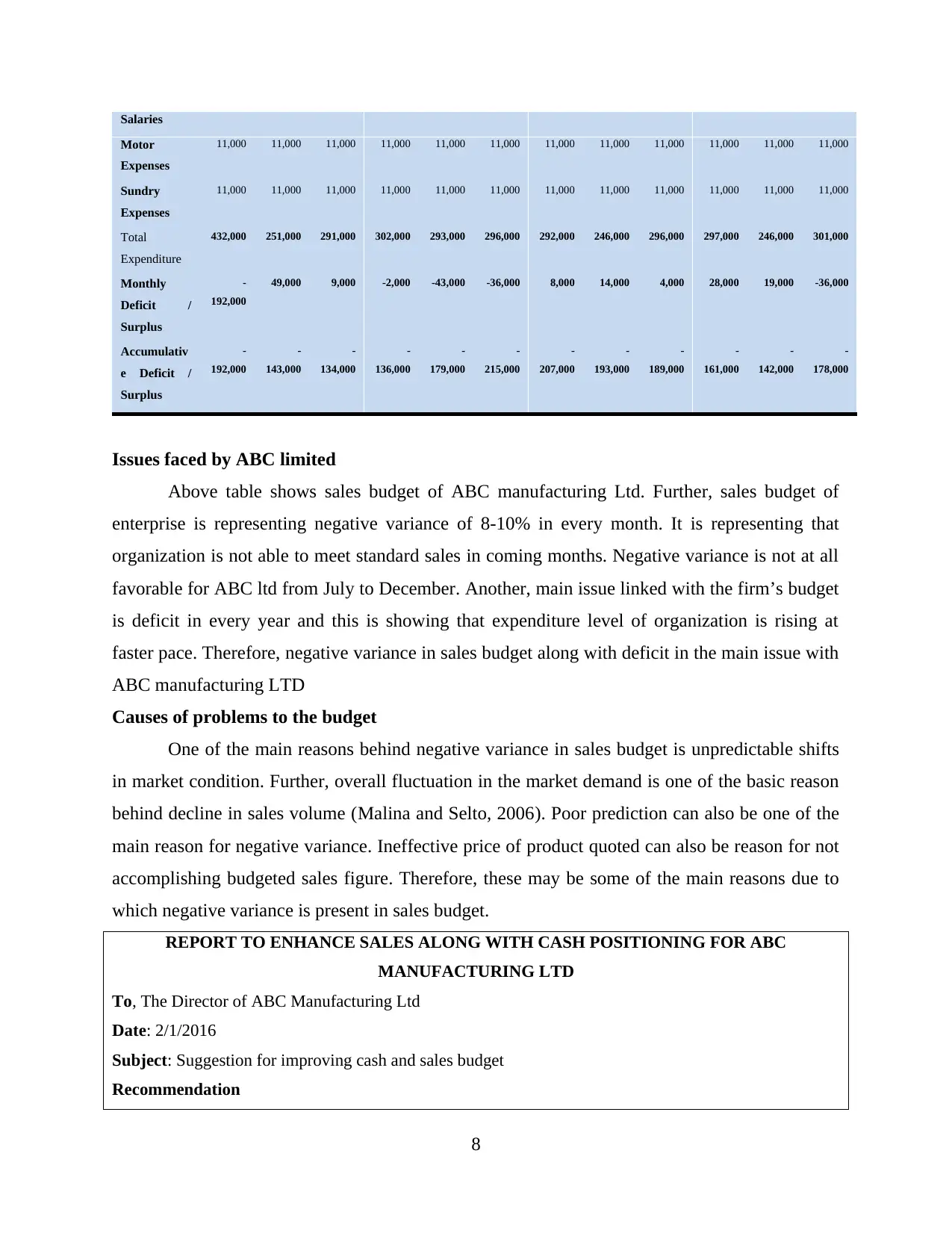
Salaries
Motor
Expenses
11,000 11,000 11,000 11,000 11,000 11,000 11,000 11,000 11,000 11,000 11,000 11,000
Sundry
Expenses
11,000 11,000 11,000 11,000 11,000 11,000 11,000 11,000 11,000 11,000 11,000 11,000
Total
Expenditure
432,000 251,000 291,000 302,000 293,000 296,000 292,000 246,000 296,000 297,000 246,000 301,000
Monthly
Deficit /
Surplus
-
192,000
49,000 9,000 -2,000 -43,000 -36,000 8,000 14,000 4,000 28,000 19,000 -36,000
Accumulativ
e Deficit /
Surplus
-
192,000
-
143,000
-
134,000
-
136,000
-
179,000
-
215,000
-
207,000
-
193,000
-
189,000
-
161,000
-
142,000
-
178,000
Issues faced by ABC limited
Above table shows sales budget of ABC manufacturing Ltd. Further, sales budget of
enterprise is representing negative variance of 8-10% in every month. It is representing that
organization is not able to meet standard sales in coming months. Negative variance is not at all
favorable for ABC ltd from July to December. Another, main issue linked with the firm’s budget
is deficit in every year and this is showing that expenditure level of organization is rising at
faster pace. Therefore, negative variance in sales budget along with deficit in the main issue with
ABC manufacturing LTD
Causes of problems to the budget
One of the main reasons behind negative variance in sales budget is unpredictable shifts
in market condition. Further, overall fluctuation in the market demand is one of the basic reason
behind decline in sales volume (Malina and Selto, 2006). Poor prediction can also be one of the
main reason for negative variance. Ineffective price of product quoted can also be reason for not
accomplishing budgeted sales figure. Therefore, these may be some of the main reasons due to
which negative variance is present in sales budget.
REPORT TO ENHANCE SALES ALONG WITH CASH POSITIONING FOR ABC
MANUFACTURING LTD
To, The Director of ABC Manufacturing Ltd
Date: 2/1/2016
Subject: Suggestion for improving cash and sales budget
Recommendation
8
Motor
Expenses
11,000 11,000 11,000 11,000 11,000 11,000 11,000 11,000 11,000 11,000 11,000 11,000
Sundry
Expenses
11,000 11,000 11,000 11,000 11,000 11,000 11,000 11,000 11,000 11,000 11,000 11,000
Total
Expenditure
432,000 251,000 291,000 302,000 293,000 296,000 292,000 246,000 296,000 297,000 246,000 301,000
Monthly
Deficit /
Surplus
-
192,000
49,000 9,000 -2,000 -43,000 -36,000 8,000 14,000 4,000 28,000 19,000 -36,000
Accumulativ
e Deficit /
Surplus
-
192,000
-
143,000
-
134,000
-
136,000
-
179,000
-
215,000
-
207,000
-
193,000
-
189,000
-
161,000
-
142,000
-
178,000
Issues faced by ABC limited
Above table shows sales budget of ABC manufacturing Ltd. Further, sales budget of
enterprise is representing negative variance of 8-10% in every month. It is representing that
organization is not able to meet standard sales in coming months. Negative variance is not at all
favorable for ABC ltd from July to December. Another, main issue linked with the firm’s budget
is deficit in every year and this is showing that expenditure level of organization is rising at
faster pace. Therefore, negative variance in sales budget along with deficit in the main issue with
ABC manufacturing LTD
Causes of problems to the budget
One of the main reasons behind negative variance in sales budget is unpredictable shifts
in market condition. Further, overall fluctuation in the market demand is one of the basic reason
behind decline in sales volume (Malina and Selto, 2006). Poor prediction can also be one of the
main reason for negative variance. Ineffective price of product quoted can also be reason for not
accomplishing budgeted sales figure. Therefore, these may be some of the main reasons due to
which negative variance is present in sales budget.
REPORT TO ENHANCE SALES ALONG WITH CASH POSITIONING FOR ABC
MANUFACTURING LTD
To, The Director of ABC Manufacturing Ltd
Date: 2/1/2016
Subject: Suggestion for improving cash and sales budget
Recommendation
8
Paraphrase This Document
Need a fresh take? Get an instant paraphrase of this document with our AI Paraphraser

Considering the present scenario financial position of firm is not effective and ABC ltd is dealing with
issue of negative variance. Further, it is required for management to focus on development of effective
pricing strategies where prices of commodities can be set as per market conditions. Apart from this proper
budgeting methods can enhance functions of business. Company is recommended to hire efficient
workforce who can meet sales target and can support in reducing the expenditure level. Apart from this
cost controlling methods can be undertaken by business for its overall growth.
Financial accountant
XYZ consultancy
Scenario 2
Capital investment techniques are undertaken for assessing viability of the proposal and
on the basis of this it is decided whether to allocate funds in investment proposal or not.
Initial investment £ 450,000 Initial investment £ 450,000
YEAR Project ‘A’ Project ‘B’
1 £ 180,000 £ 60,000
2 £ 230,000 £ 120,000
3 £ 280,000 £ 250,000
4 £ 120,000 £ 250,000
Payback period
It indicates the time period in which invested amount can be recovered back easily.
In case of even cash flow
Payback Period= Initial Investment/ cash inflow per period
For uneven cash flows,
Pay back Period= A+B/C
A = last year value with a negative cumulative cash flow
B = absolute value of cumulative cash flow at the end of the period A
9
issue of negative variance. Further, it is required for management to focus on development of effective
pricing strategies where prices of commodities can be set as per market conditions. Apart from this proper
budgeting methods can enhance functions of business. Company is recommended to hire efficient
workforce who can meet sales target and can support in reducing the expenditure level. Apart from this
cost controlling methods can be undertaken by business for its overall growth.
Financial accountant
XYZ consultancy
Scenario 2
Capital investment techniques are undertaken for assessing viability of the proposal and
on the basis of this it is decided whether to allocate funds in investment proposal or not.
Initial investment £ 450,000 Initial investment £ 450,000
YEAR Project ‘A’ Project ‘B’
1 £ 180,000 £ 60,000
2 £ 230,000 £ 120,000
3 £ 280,000 £ 250,000
4 £ 120,000 £ 250,000
Payback period
It indicates the time period in which invested amount can be recovered back easily.
In case of even cash flow
Payback Period= Initial Investment/ cash inflow per period
For uneven cash flows,
Pay back Period= A+B/C
A = last year value with a negative cumulative cash flow
B = absolute value of cumulative cash flow at the end of the period A
9
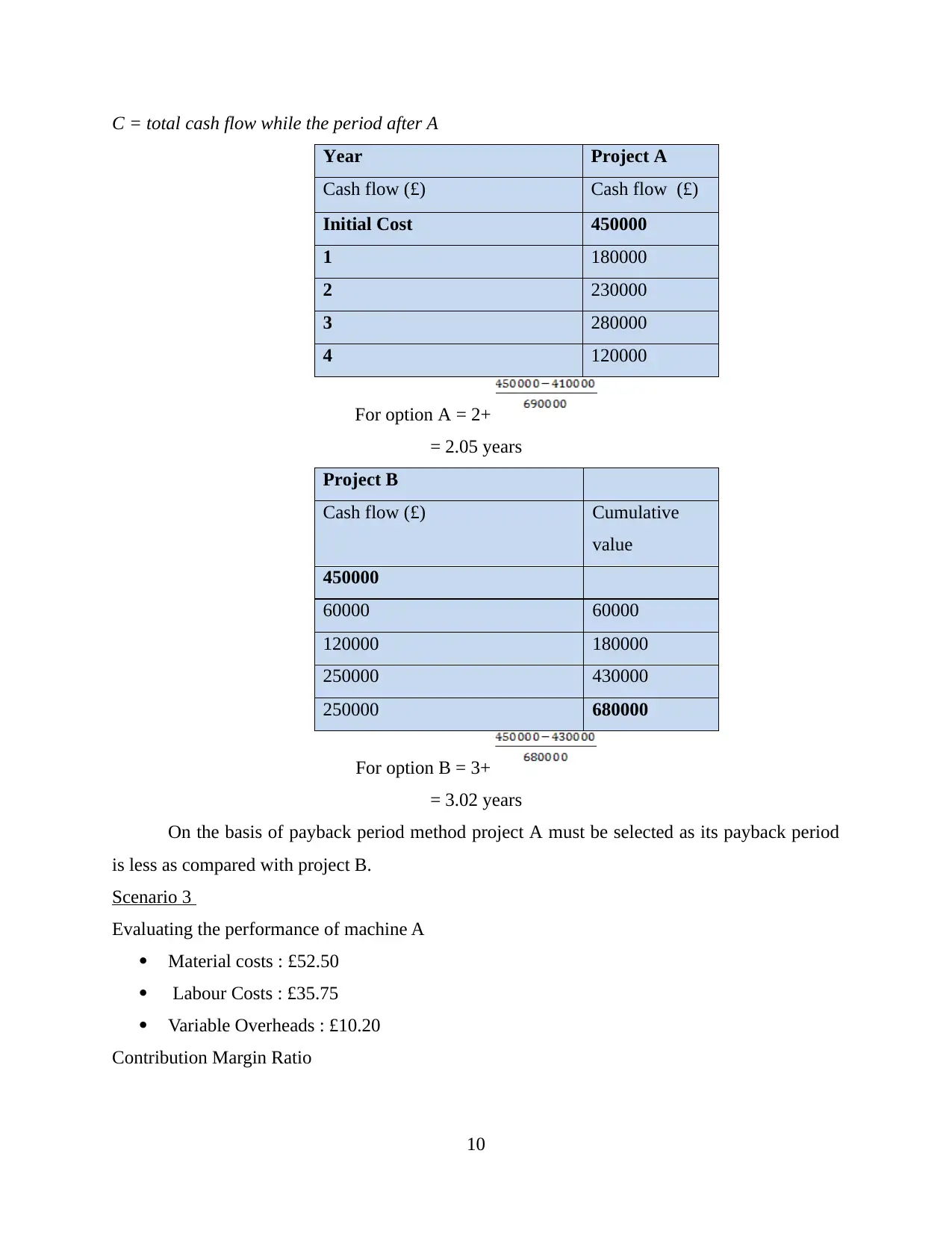
C = total cash flow while the period after A
Year Project A
Cash flow (£) Cash flow (£)
Initial Cost 450000
1 180000
2 230000
3 280000
4 120000
For option A = 2+
= 2.05 years
Project B
Cash flow (£) Cumulative
value
450000
60000 60000
120000 180000
250000 430000
250000 680000
For option B = 3+
= 3.02 years
On the basis of payback period method project A must be selected as its payback period
is less as compared with project B.
Scenario 3
Evaluating the performance of machine A
Material costs : £52.50
Labour Costs : £35.75
Variable Overheads : £10.20
Contribution Margin Ratio
10
Year Project A
Cash flow (£) Cash flow (£)
Initial Cost 450000
1 180000
2 230000
3 280000
4 120000
For option A = 2+
= 2.05 years
Project B
Cash flow (£) Cumulative
value
450000
60000 60000
120000 180000
250000 430000
250000 680000
For option B = 3+
= 3.02 years
On the basis of payback period method project A must be selected as its payback period
is less as compared with project B.
Scenario 3
Evaluating the performance of machine A
Material costs : £52.50
Labour Costs : £35.75
Variable Overheads : £10.20
Contribution Margin Ratio
10
⊘ This is a preview!⊘
Do you want full access?
Subscribe today to unlock all pages.

Trusted by 1+ million students worldwide
1 out of 22
Related Documents
Your All-in-One AI-Powered Toolkit for Academic Success.
+13062052269
info@desklib.com
Available 24*7 on WhatsApp / Email
![[object Object]](/_next/static/media/star-bottom.7253800d.svg)
Unlock your academic potential
Copyright © 2020–2025 A2Z Services. All Rights Reserved. Developed and managed by ZUCOL.





